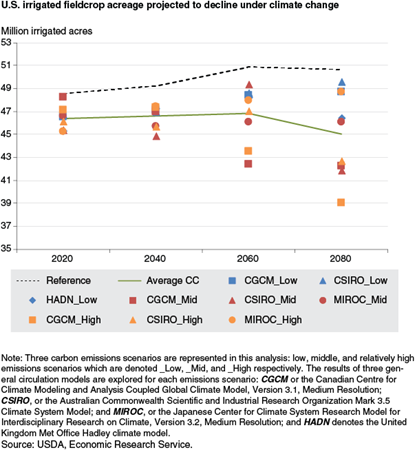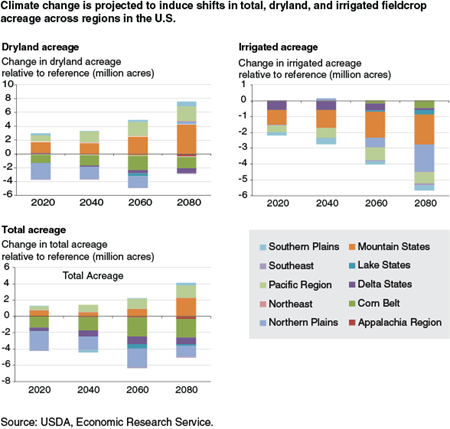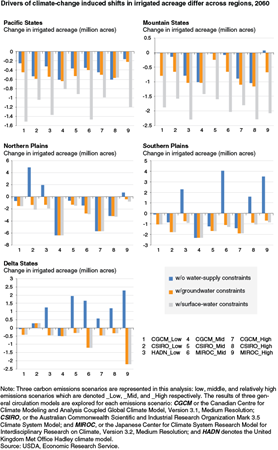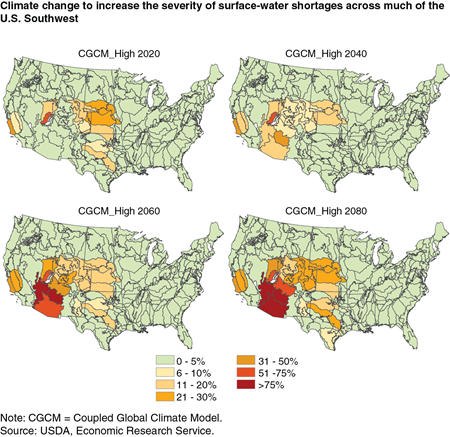Climate Change, Water Scarcity, and Adaptation
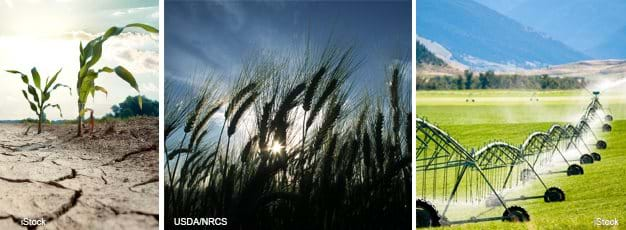
Highlights:
-
Climate change is projected to reduce average yields over the next century for major U.S. field crops—corn, soybeans, rice, sorghum, cotton, oats, and silage—under both irrigated and dryland production, relative to projected yields assuming no climate change. Yields for wheat, hay, and barley, by contrast, are often projected to increase.
-
Irrigation is widely viewed as an important adaptation to shifting production conditions under climate change. This analysis projects, however, that irrigated fieldcrop acreage will decline as a result of climate change over the 2020 to 2080 study period. Before midcentury, the decline in irrigated acreage is largely driven by regional constraints on surface-water availability for irrigation. Beyond midcentury, the decline reflects a combination of increasing surface-water shortages and declining relative profitability of irrigated production.
-
Factors driving the shifting relative profitability of irrigation under climate change vary by region but include: shifting patterns of precipitation, which affect both costs of irrigation (through volume of water applied) and the yield premium achievable through irrigation; temperature-related crop yield impacts for both dryland and irrigated production; and differences in carbon dioxide fertilization impacts on crops grown in dryland production versus those that are predominantly irrigated.
We are all affected by daily weather changes, but few people are as vulnerable to changeable patterns of rainfall and temperature as farmers. Farmers stake their livelihoods on weather patterns that are highly variable and largely unpredictable. As a result, farmers have developed strategies for responding to local weather patterns and variability, including changes in planting dates, crops planted, and production methods used in accordance with spring weather conditions. National and global shifts in climate, however, present new challenges as agriculture faces unfamiliar climatic conditions and greater incidence of extreme weather.
Expanded irrigation is often proposed as a strategy that may help farmers maintain production levels in a warmer world. However, the potential of expanded irrigation as an adaptation to climate change will be constrained by the availability of irrigation water in many regions. Groundwater supplies are in decline across major irrigated areas, and surface-water supplies for agriculture are particularly vulnerable to shifts in precipitation, water cycling, and demand for water in nonagricultural sectors. Furthermore, irrigation demand depends on economic incentives to adopt irrigation, which may respond in counterintuitive ways due to altered growing conditions and shifting irrigated and dryland yields.
Recent ERS research simulates potential yield, production, and price impacts of changing climate conditions on the U.S. fieldcrop sector and explores the implications of those changes for farmer decisionmaking and welfare in the years 2020, 2040, 2060, and 2080. There is considerable uncertainty about global carbon emissions, and their impacts on climate, over the next century. ERS research uses climate change projections developed in support of the U.S. Forest Service’s 2010 Resources Planning Act Assessment; three different assumptions about future carbon emissions were run, each through three separate general circulation models, to generate nine potential climate futures. To examine the potential role of irrigation as an adaptation strategy under these climate futures, ERS research focuses on regional incentives to adopt irrigation under future climate projections, as well as on the regional significance of irrigation constraints arising from reductions in groundwater withdrawals and climate-related changes in surface-water supply.
Crop yields and output expected to decline as a result of climate change
Potential yield premiums—the increase in irrigated yield relative to dryland production—are the major incentive for farmers to apply irrigation. However, yields of several major field crops, both irrigated and dryland, are projected in the study analysis to decline under climate change (when measured against reference yields that assume trend growth in crop productivity). From mid-to-late century, average yields generally decline for corn, soybeans, sorghum, rice, cotton, oats, and silage as a result of projected changes in growing conditions, including regional shifts in precipitation and temperature and broader changes in atmospheric carbon dioxide concentrations. Yields of wheat, hay, and barley, on the other hand, are generally boosted by climate change after mid-century. Changes in yield, together with projected shifts in production as farmers adapt, generally result in a decline in aggregate U.S. production of corn, soybeans, oats, rice, silage, and sorghum under climate change.
| 2020 | 2040 | 2060 | 2080 | |
|---|---|---|---|---|
| Barley (bushels) | -1.9 | -0.6 | -3.5 | 1.0 |
| Corn (bushels) | -8.1 | -8.7 | -13.8 | -16.2 |
| Cotton (bales) | -7.9 | -6.1 | -5.6 | -5.9 |
| Hay (dry ton) | -4.0 | -0.6 | 2.7 | 4.2 |
| Oats (bushels) | -8.7 | -10.7 | -16.1 | -20.8 |
| Rice (cwt) | -2.2 | -2.5 | -4.2 | -6.1 |
| Silage (dry ton) | -6.9 | -9.5 | -13.1 | -14.4 |
| Sorghum (bushels) | -15.1 | -5.4 | -14.0 | -17.0 |
| Soybeans (bushels) | -8.1 | -8.8 | -11.9 | -14.3 |
| Wheat (bushels) | -2.8 | 1.3 | 5.6 | 11.6 |
| Note: Percent changes in total U.S. production include irrigated and dryland production, when averaged over future climate change scenarios and compared to reference production levels that assume no climate change. Source: USDA, Economic Research Service. |
||||
Prices expected to rise, crop profits decline under climate change
Shifts in the profitability of irrigated versus dryland production also depend on future crop prices, as higher prices can help offset reduced yield in determining the profit premium achievable through irrigation. With reduced production, climate change generally increases the production-weighted price index calculated across crops. Estimated price impacts are sensitive to the climate scenario considered, however. For most climate projections, an index of fieldcrop prices responds to the decline in total production by increasing (relative to its reference levels without climate change); under only one climate scenario, which projects a (relatively) wetter and cooler future, does the price index decline in 2040 and beyond due to climate change.
While consumers are unambiguously worse off when crop prices increase, producers can benefit as price increases help offset revenue losses from lower yields and reduced output. Producers in this analysis, however, are unable to fully recover the losses suffered from yield declines, and total profits across the fieldcrop sector generally decline as result of climate change, where profits are measured as the difference between revenue and variable production costs. The balance of price effect versus production/yield effect plays out differently across different crops, however. In 2040, for example, profits are anticipated to decline for major crops such as corn and soybeans but increase for crops such as rice and sorghum, where rising prices offset the effect of production declines.
The regional implications of climate change depend on which crops are typically grown, how those crops are affected by climate change, and how the mix of acreage in production changes as farmers adapt. In 2060, the profitability of fieldcrop production generally declines across major production regions. The Corn Belt—the major production region for corn and soybeans, which are relatively sensitive to rising temperatures—suffers declines in producer returns across all climate scenarios considered. The Pacific region experiences increases in profits across fieldcrop sectors under most scenarios but is not a major producing area for many such crops. The remaining regions experience mixed impacts across climate scenarios, with predominantly negative impacts (i.e., across six or more of the nine climate scenarios) in the Appalachian, Delta, Lake States, Mountain, Northern Plains, and Southeast regions. The Southern Plains shows an increase in total profits within the fieldcrop sector in five of the nine climate scenarios, largely owing to increases in returns to hay and cotton.
Irrigated acreage and applied irrigation water decline under climate change
Despite a general warming, irrigated production acreage across the United States is projected to contract under climate change relative to a reference case that assumes no climate change. This decline in irrigated acreage is accompanied by a drop in total applied irrigation by volume. This result, which is surprising in that expanded irrigation would seem a likely strategy in mitigating climate impacts, emerges from a complicated set of dynamics at both the field and regional levels.
In some cases, declines in regional irrigated acreage are accompanied by increased growing-season precipitation in that region. Increased precipitation may erode the relative profitability of irrigated systems by narrowing the difference in yields achievable on dryland versus irrigated acreage. Given the higher costs associated with irrigated cropping systems, the lower yield premium may be sufficient to induce a shift from irrigated toward dryland production.
In other cases, however, decreased regional irrigated acreage and/or reductions in applied irrigation volume are accompanied by declines in regional precipitation. Our projections suggest that available irrigation water supply will decline significantly in some regions, with shortages increasing over time (see box). While farmers may have the incentive to adopt irrigation in those regions, constraints on the availability of water may prevent such expansion.
Even without water supply constraints, irrigated acreage and/or applied irrigation volume may decline despite less precipitation in some regions. From a biophysical perspective, crop demand for irrigation water may decline despite warmer temperatures and decreased precipitation, reflecting the interaction of biomass accumulation, heat stress, and water demand over a full growing season. In such cases, it appears that heat stress in a warming world is sufficient to slow crop growth and reduce biomass, thereby reducing crop-water evapotranspiration and irrigation demand despite the warmer temperatures.
Economic incentives to reduce irrigated acreage under warmer conditions may arise when the premium received by irrigated production declines, as when the decline in irrigated crop yields from temperature stress are larger than the drop in dryland yields from temperature stress. When crops like wheat or hay that are grown in predominantly dryland production systems are affected less by temperature stress—or benefit more from the positive yield impacts of carbon dioxide fertilization—than crops (like corn) which may be grown in irrigated production systems, farmers may transfer production into dryland crop systems.
Drivers of irrigated acreage change vary by region
At a regional level, irrigated acreage may contract as part of a larger loss of production acreage. While the magnitude of change is variable across climate scenarios, fieldcrop acreage in some regions declines by up to 19 percent in 2080 relative to the reference case without climate change. Climate change alters the competitiveness of production across regions, inducing shifts in production between regions. Several important crop production regions—including the Corn Belt, Northern Plains, and Delta regions—see losses in production acreage under altered climate conditions.
The chart below illustrates regional shifts in irrigated acreage in 2060 to demonstrate the relative importance of different drivers of acreage change. The blue bars reveal climate impacts assuming no limitations on water for irrigation, while the orange and grey bars represent impacts when limitations on groundwater and surface-water supplies are applied in succession.
In the Pacific region, irrigated acreage contracts or remains the same for all climate scenarios, even without irrigation constraints, suggesting an increase in the relative profitability of dryland production systems, particularly in the northwestern wheat- and hay- producing subregions.
Irrigated acreage in the Mountain region also declines under most climate projections, reflecting the dual effect of declining relative returns to irrigation—particularly in the northern latitudes—and increasingly limited water supplies in the central and southern river basins.
In the absence of water-supply constraints in the Southern Plains, irrigated acreage expands or declines depending on the climate projection. In general, returns to irrigated production, and irrigated acreage, increase relative to dryland production in the northern and central subregions, with some increases also observed in the Gulf Coast area. The introduction of water-supply constraints—primarily reduced groundwater withdrawals from the Ogallala Aquifer—results in a net decrease in irrigated acreage across all crops.
The Northern Plains shows declining irrigated acreage under most climate projections, even when water supplies are not limited. Increased precipitation, combined with reduced returns to irrigated corn and generally higher wheat and hay yields, drive an increase in the relative profitability of regional dryland production. However, dryland acreage also declines across several climate scenarios, reflecting declining yields in corn and soybean production.
In the Delta States, irrigated acreage expands under most climate projections in the absence of water constraints. That expansion is driven, in part, by large declines in regional dryland yields. When water-supply constraints are imposed, both irrigated and total acreage in production decline under most climate projections.
Technology can increase agricultural resilience to climate change by improving both plant water-use efficiency (yield per unit of water uptake) and the efficiency of applied irrigation. U.S. seed companies have recently released several corn hybrids developed for tolerance to drought. This research, however, suggests that a greater understanding of the relationship between temperature and crop yield and development of crop varieties whose yields are more robust to temperature stress, particularly during critical growth and grain-filling periods, may be critical to building long-term resilience to climate change. The relationship between drought tolerance and temperature sensitivity will also likely be an important factor in technology development; a plant variety developed for drought tolerance may not retain its improved drought tolerance under higher temperatures.
Moving forward under climate change
Irrigation is widely viewed as an important adaptation to shifting production conditions under climate change. While irrigation expansion may help mitigate climate effects in some regions, our results suggest that the biophysical yield impacts associated with climate change may drive shifts in the relative profitability of irrigated versus dryland production in ways that limit irrigation incentives even when sufficient irrigation water is available. While climate effects are expected to reduce water supplies across much of the arid West, declines in the relative profitability of irrigation appear to temper incentives for irrigation expansion under many climate projections in the United States.
Due to changes in yields and shifts in relative profitability across dryland and irrigated production systems, this analysis projects increased reliance on dryland production under climate change. Strengthening the resilience of dryland agriculture to heat and drought will also be critical in building agriculture’s adaptive capacity. Measures with the potential to increase the resilience of dryland systems could include development and diffusion of crop cultivars more tolerant of heat and water stress, as well as soil management practices that improve soil moisture retention (e.g., tillage or cover crops); development of forecasting and decisionmaking tools that enable farmers to more closely align the timing of cropping operations with improved temperature and precipitation predictions; and insurance programs/financial strategies that mitigate production risk.
<a name="sidebar1">Irrigation water availability shifts under climate change</a>
Climate-change induced shifts in precipitation patterns, limits on the availability of groundwater withdrawals, and shifting water demands from nonagricultural sectors will all affect the amount of irrigation water available to crop producers. Projected reductions in surface-water supplies for irrigation are centered largely in the Mountain, Pacific, and Plains regions and are most severe in the middle and lower Colorado River Basin. (Other river systems with headwaters in the central Rocky Mountains and Sierra Nevada range are affected to varying degrees, depending on climate scenario.) The figure below illustrates the estimated surface-water reductions associated with one of the nine climate projections:
Climate Change, Water Scarcity, and Adaptation in the U.S. Fieldcrop Sector, by Elizabeth Marshall, Marcel Aillery, Scott Malcolm, and Ryan Williams, ERS, November 2015


